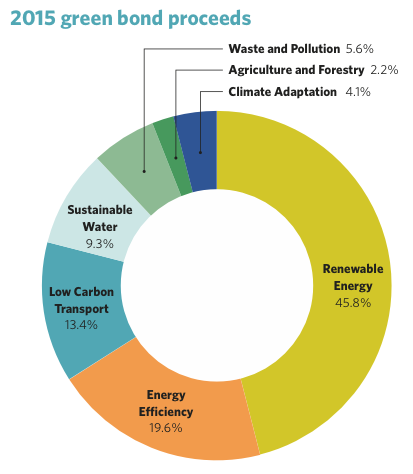
Climate Bonds Initiative has launched a new Technical Working Group (TWG) to begin work on Phase II of the Climate Bonds Standard Water Criteria. These Criteria will be used to screen water assets and projects, identifying those that appropriately address climate risks and can therefore be certified under the Climate Bonds Standard.
Phase I focussed on Grey Infrastructure Assets
Phase I of the Water Criteria and the initial TWG focussed primarily on screening grey (built) infrastructure projects and assets. During the latter stages of this development of Phase I, it became apparent that an in-depth look at water-related nature based green infrastructure would be beneficial to investors and issuers.
Water infrastructure is a very broad field and there is a need for Climate Bonds Criteria to encompass both grey and green infrastructure, built and natural water assets.
Phase II will focus on Nature Based Green Infrastructure Assets
Phase II will thus develop criteria for screening nature based green infrastructure for water projects and natural asset restoration and remediation.
Both Phase I & II include climate mitigation, adaptation and resilience factors.

Dr John Matthews, AGWA & TWG Lead Specialist
 “Evaluating and financing these [green infrastructure] approaches as investments that can compete against traditional grey solutions in terms of efficacy and profit marks a profound change.”
“Evaluating and financing these [green infrastructure] approaches as investments that can compete against traditional grey solutions in terms of efficacy and profit marks a profound change.”
“Although our Technical Working Group has just started its work, I can already see dramatic, exciting ways to showcase, evaluate, and compare nature-based solutions to climate mitigation and adaptation.”
“I have hope that we may being moving from isolated "pilot" projects to unleashing the power of global markets to effect transformational solutions to significant environmental and economic challenges.”
The Water Phase II TWG has had its initial meeting and will reconvene on a monthly basis. It will develop recommended criteria for public consultation, before being reviewed by the Climate Bonds Standards Board.
An Industry Working Group (IWG) will also be convened. The role of the IWG will be to evaluate the proposed criteria and provide feedback on feasibility, credibility, potential demand and industry interest. Once the TWG have developed, and the IWG have reviewed, the criteria they will release them for public consultation.
Who’s involved?
The TWG is made up of industry experts and academics authorities from various water related disciplines. As a result, the proposed criteria will reflect the insights and experiences of multiple institutions and disciplines.
TWG Lead Specialist
 |
|||
|
Alliance for Global Water Adaptation |
|
|
|
Technical Working Group Members
 |
 |
 |
 |
 |
| World Bank Group's Environment & Natural Resources Global Practice Valerie Hickey |
California Organized Investment Network (COIN) Peter Streit Investment Officer |
European Investment Bank Nancy Saich Senior Advisor on Climate Action & Environment |
UNESCO-IHE Prof. Michael McClain Professor of Ecohydrology |
World Business Council for Sustainable Development Tatiana Fedotova Manager, Water Cluster |
 |
 |
 |
 |
 |
| University of North Carolina Dr. Larry Band Director, Institute for the Environment |
Tetra Tech Dan Christian Senior Water Resource Engineer |
Deltares Cees van de Guchte Scenarios & Policy Analysis |
American Water Works Association Cynthia Lane Director of Engineering & Technical Services |
IUCN Global Water Programme Dr. James Dalton Coordinator Global Water Initiatives |
 |
 |
 |
 |
 |
| UNEP-DHI Partnership Maija Bertule Programme Advisor |
Alliance for Global Water Adaptation Christine Chan |
Ceres Monika Freyman Director, Water Program |
World Resources Institute Todd Gartner Senior Associate, Food, Forests & Water Program |
Stockholm International Water Institute John Joyce Chief Economist, Water Economics |
 |
 |
 |
 |
 |
| UNEP Dr. Musonda Mumba Ecosystem Based Adaptation (EBA) Flagship Programme Coordinator |
Deloitte Consulting LLP Will Sarni Director & Practice Leady, Water Strategy, Social Impact Services |
Earth Security Group Margot Hill Clarvis Senior Manager |
Organica Water Ari Raivetz CEO |
Stockholm International Water Institute Torgny Holmgren Executive Director |
 |
 |
 |
 |
 |
| Charles Rives Watershed Association Bob Zimmerman Executive Director |
Bioatlatlantic Institute Marco Follador Director of Adaptation Planning |
University of California, Division of Agriculture & Natural Resources Ted Grantham Cooperative Extension Specialist in Climate & Water |
Denver Water Laurna Kaatz Climate Scientist |
ICATALIST Dr. Elena Lopez-Gunn Director |
 |
 |
 |
 |
 |
| 2030 Water Resources Group (hosted by IFC) Rochi Khemka Regional Coordinator |
Conservation International Dave Hole Senior Director, Global Synthesis |
U.S. Army Corps of Engineers Debbie Larson-Salvatore Institute for Water Resources |
The Nature Conservancy Jorge Gastelumendi Senior Policy Advisor |
Arup Jason Fairbairn Senior Hydrogeologist |
 |
 |
 |
 |
 |
| U.S. Army Corps of Engineers Charles B Chestnutt Institute for Water Resources |
Global Environment Facility Christian Severin Senior Environmental Specialist |
International Institute for Applied Systems Analysis Junguo Liu Research Scholar Ecosystems Service & Management |
U.S. Environmental Protection Agency Lisa Hair Senior Environmental Engineer |
US Geological Survey Janet Cushing Deputy Chief, National Climate Change & Wildlife Science Center |
 |
||||
| Beijing Forest University Benjamin Denjean |
Why Phase II is necessary?
It is becoming increasingly apparent how much of a buffer natural water based assets can provide against a changing climate. These aren’t ‘built’ to provide a buffer, but can often be just as effective as grey infrastructure and can be enhanced for this purpose through active restoration and improved conservation.
The Water Criteria Phase II will help to address this environmental challenge. By detailing what nature based solutions can contribute meaningfully to the necessary rapid transition to a low carbon economy it will allow investors to better prioritise these water based investments. It will also clarify to issuers what projects and assets can and should be included in green bonds.
Todd Gartner Senior Associate for the World Resources Institute’s Food, Forests & Water Program:
 “Green and grey water infrastructure must be upgraded, designed and maintained with a climate resilience and adaptation focus, whilst maximising opportunities for climate mitigation. If current and future water infrastructure is to support communities it must be climate resilient.”
“Green and grey water infrastructure must be upgraded, designed and maintained with a climate resilience and adaptation focus, whilst maximising opportunities for climate mitigation. If current and future water infrastructure is to support communities it must be climate resilient.”
Who’s Done What in Water So Far?
 Green bonds are already being issued for sustainable water; they made up almost 10% of 2015 green bond proceeds.
Green bonds are already being issued for sustainable water; they made up almost 10% of 2015 green bond proceeds.
In mid-2014 DC Water led the way with its USD 350m, 100 year ‘green century’ bond, with proceeds for storm water and wastewater treatment. Other green water bonds have come from the City of Cleveland, City of Saint Paul’s, Indiana Finance Authority and the California Infrastructure and Economic Development Bank amongst others.
The San Francisco Public Utility Commission is the latest to come to market with its May 2016 USD 240m certified green water bond: the first bond to be Climate Bonds Certified using the Water Criteria Phase I.
Earlier this year, on World Water Day, The White House recognised this on-going work on low carbon water investments in its report ‘Commitments to Action on Building a Sustainable Water Future’. This report illustrates that the majority of US action on sustainable water currently focuses on grey water infrastructure.
Phase II of the Water Criteria will help to broaden understanding of the intersection of water-related green infrastructure investment with climate adaptation and resilience.
The Last word
 “The critical lens of climate must be used to assess future water investments, green and grey. We need to shift investable capital in a short space of time. The Water Criteria’s evaluation of water related green bonds will boost investor confidence and issuer clarity.”
“The critical lens of climate must be used to assess future water investments, green and grey. We need to shift investable capital in a short space of time. The Water Criteria’s evaluation of water related green bonds will boost investor confidence and issuer clarity.”
“Water issues are pervasive across so many facets of climate change and sustainability challenges. The extension of criteria development to the natural environment and water-based ecosystems is a logical step to undertake.”
Justine Leigh-Bell, Head of Standards, Climate Bonds Initiative
The Water Criteria are kindly supported by:


Disclaimer: The information contained in this communication does not constitute investment advice and the Climate Bonds Initiative is not an investment adviser. Links to external websites are for information purposes only. The Climate Bonds Initiative accepts no responsibility for content on external websites.
The Climate Bonds Initiative is not advising on the merits or otherwise of any investment. A decision to invest in anything is solely yours. The Climate Bonds Initiative accepts no liability of any kind for investments any individual or organisation makes, nor for investments made by third parties on behalf of an individual or organisation.
